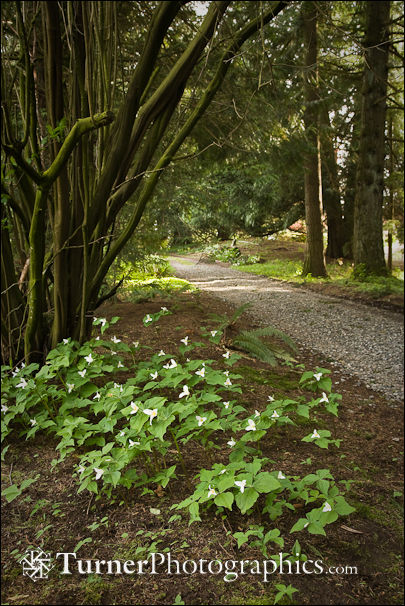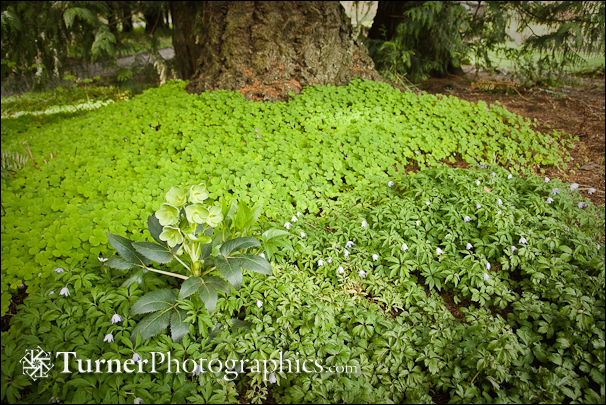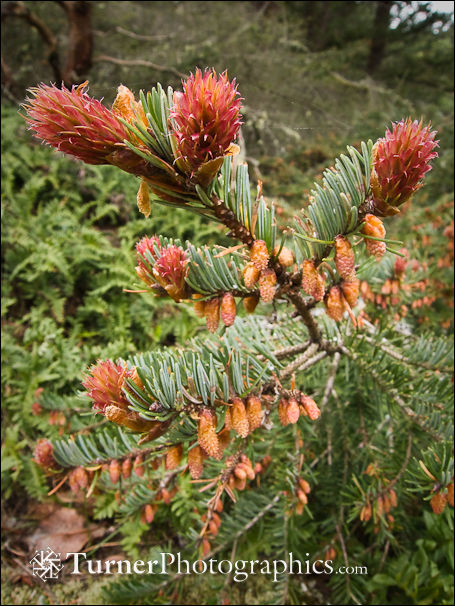 Using native plants in your garden is becoming more and more popular, and for good reason. They’re hardy, adapted to your climate, and resistant to many diseases and insects. Plus, we’ve got a lot of really gorgeous and desirable plants that are native to our part of the world.
Using native plants in your garden is becoming more and more popular, and for good reason. They’re hardy, adapted to your climate, and resistant to many diseases and insects. Plus, we’ve got a lot of really gorgeous and desirable plants that are native to our part of the world.
Several days ago one of my gardening friends who lives a few miles outside Bellingham invited me out to see and photograph her early spring garden. These western trilliums, Trillium ovatum, are what greeted me as I came up the long gravel driveway toward her home. This patch has obviously been growing here for many years and is slowly spreading. They’re in a woodland habitat, but get morning sun.
If you’re fortunate to have this plant in your garden, which I do, look around at the base of the big plants for the babies. Note how the first-year plants only have a single leaf, two-year olds have two leaves, and those three and over have the typical three leaves of an adult plant. It may take more than three years from seed for a trillium to flower so your patience will be rewarded.
 There’s no gardening rule that says you have to use either all natives or all exotics in your garden. Here Sherri has planted lungwort, Pulmonaria sp., in the same bed with the trilliums. I like the contrast of the speckled foliage and blue blossoms of the lungwort with the dazzling white trillium blossoms behind.
There’s no gardening rule that says you have to use either all natives or all exotics in your garden. Here Sherri has planted lungwort, Pulmonaria sp., in the same bed with the trilliums. I like the contrast of the speckled foliage and blue blossoms of the lungwort with the dazzling white trillium blossoms behind.
One of the keys to garden design is to mix complementary colors and textures together. I think this pair combines very nicely. Both are perennials with foliage that will look decent through most of the summer if they don’t get too hot or too dry. The blossoms will disappear but that’s OK. We’ll enjoy them now and move on to some other part of the garden later in the season.

One of our nicest native groundcovers is redwood sorrel, Oxalis oregana. It isn’t truly native here in Whatcom County, but it is a northwest native that grows very well here when planted. In fact, it can become invasive if you don’t watch out. In this photo it’s the plant toward the back at the base of the big Douglas-fir. The other two prominent plants here are wood anemone and a Corsican hellebore.
Again, Sheri has combined natives and non-natives in the same bed, taking advantage of contrasting textures, leaf shapes, and foliage colors.
These photos were made fairly late in the afternoon under overcast skies, with more wind than I would have liked. I cranked the ISO up to 400 to get a higher shutter speed. Some of the newer high-end cameras have low enough noise to go even higher, but I start to notice the noise with my Canon EOS 1Ds Mk II when I go above 400. Even so, coming from shooting Fuji Velvia at ISO 50, being able to use ISO 400 reliably is a blessing. That’s a three-stop improvement, which can make all the difference needed to stop plants blowing in the breeze from blurring in the frame.



 The most compelling photos are often made eye to eye with the subject. That means that if you’re photographing a child, pet, or small plant you’ll want to get down low so your camera’s lens is roughly at the same level as your subject’s eyes. If it’s a flower then that’s your eye level.
The most compelling photos are often made eye to eye with the subject. That means that if you’re photographing a child, pet, or small plant you’ll want to get down low so your camera’s lens is roughly at the same level as your subject’s eyes. If it’s a flower then that’s your eye level. 
 Using native plants in your garden is becoming more and more popular, and for good reason. They’re hardy, adapted to your climate, and resistant to many diseases and insects. Plus, we’ve got a lot of really gorgeous and desirable plants that are native to our part of the world.
Using native plants in your garden is becoming more and more popular, and for good reason. They’re hardy, adapted to your climate, and resistant to many diseases and insects. Plus, we’ve got a lot of really gorgeous and desirable plants that are native to our part of the world. There’s no gardening rule that says you have to use either all natives or all exotics in your garden. Here Sherri has planted lungwort, Pulmonaria sp., in the same bed with the trilliums. I like the contrast of the speckled foliage and blue blossoms of the lungwort with the dazzling white trillium blossoms behind.
There’s no gardening rule that says you have to use either all natives or all exotics in your garden. Here Sherri has planted lungwort, Pulmonaria sp., in the same bed with the trilliums. I like the contrast of the speckled foliage and blue blossoms of the lungwort with the dazzling white trillium blossoms behind.

 Steve asked me one of the hardest questions about using small digital cameras: “How can I focus on a flower close-up and have the background soft?” Unfortunately this is one area where pocket cameras are weak, but it’s not an impossible task. There are really two issues involved here. One is that the autofocus system often wants to focus on the background rather than the subject you’re aiming for. The second is that with a small sensor you get a short focal-length lens which equates to great depth of field.
Steve asked me one of the hardest questions about using small digital cameras: “How can I focus on a flower close-up and have the background soft?” Unfortunately this is one area where pocket cameras are weak, but it’s not an impossible task. There are really two issues involved here. One is that the autofocus system often wants to focus on the background rather than the subject you’re aiming for. The second is that with a small sensor you get a short focal-length lens which equates to great depth of field. 

 Sex was in the air all over Pass Island and West Beach at Deception Pass State Park this weekend. Bright red female Douglas-fir cones standing tall on branch tips were calling out to the pollen-laden male cones hanging below. “Hit me with some of your dusty golden pollen,” they seemed to be saying. And with every stiff branch-shaking breeze (or human hand) the air would blaze with the pixie dust so essential to the Pseudotsuga menziesii mating ritual.
Sex was in the air all over Pass Island and West Beach at Deception Pass State Park this weekend. Bright red female Douglas-fir cones standing tall on branch tips were calling out to the pollen-laden male cones hanging below. “Hit me with some of your dusty golden pollen,” they seemed to be saying. And with every stiff branch-shaking breeze (or human hand) the air would blaze with the pixie dust so essential to the Pseudotsuga menziesii mating ritual.